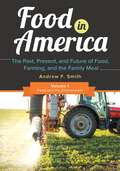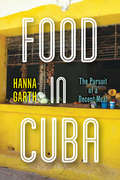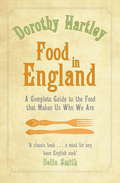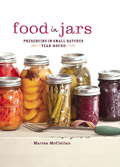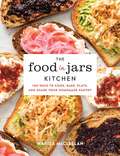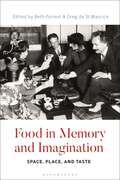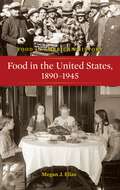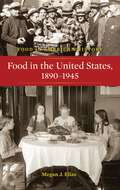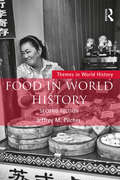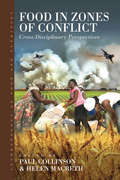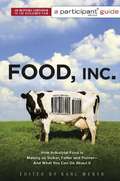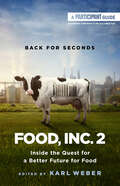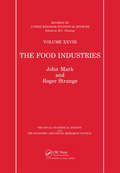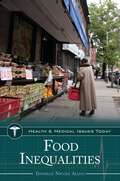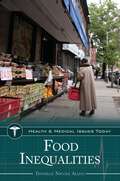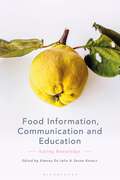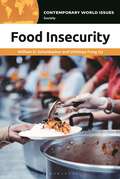- Table View
- List View
Food in America [3 volumes]: The Past, Present, and Future of Food, Farming, and the Family Meal [3 volumes]
by Andrew F. SmithThis three-volume work examines all facets of the modern U.S. food system, including the nation's most important food and agriculture laws, the political forces that shape modern food policy, and the food production trends that are directly impacting the lives of every American family.Americans are constantly besieged by conflicting messages about food, the environment, and health and nutrition. Are foods with genetically modified ingredients safe? Should we choose locally grown food? Is organic food better than conventional food? Are concentrated animal feed operations destroying the environment? Should food corporations target young children with their advertising and promotional campaigns? This comprehensive three-volume set addresses all of these questions and many more, probing the problems created by the industrial food system, examining conflicting opinions on these complex food controversies, and highlighting the importance of food in our lives and the decisions we make each time we eat.The coverage of each of the many controversial food issues in the set offers perspectives from different sides to encourage readers to examine various viewpoints and make up their own minds. The first volume, Food and the Environment, addresses timely issues such as climate change, food waste, pesticides, and sustainable foods. Volume two, entitled Food and Health and Nutrition, addresses subjects like antibiotics, food labeling, and the effects of salt and sugar on our health. The third volume, Food and the Economy, tackles topics such as food advertising and marketing, food corporations, genetically modified foods, globalization, and megagrocery chains. Each volume contains several dozen primary documents that include firsthand accounts written by promoters and advertisers, journalists, politicians and government officials, and supporters and critics of various views related to food and beverages, representing speeches, advertisements, articles, books, portions of major laws, and government documents, to name a few. These documents provide readers additional resources from which to form informed opinions on food issues.
Food in Cuba: The Pursuit of a Decent Meal
by Hanna GarthFood in Cuba follows Cuban families as they struggle to maintain a decent quality of life in Cuba's faltering, post-Soviet welfare state by specifically looking at the social and emotional dimensions of shifts in access to food. Based on extensive fieldwork with families in Santiago de Cuba, the island's second largest city, Hanna Garth examines Cuban families' attempts to acquire and assemble "a decent meal," unraveling the layers of household dynamics, community interactions, and individual reflections on everyday life in today's Cuba. With the collapse of the Soviet Union in the 1990s and the subsequent loss of its most significant trade partner, Cuba entered a period of economic hardship. Although trade agreements have significantly improved the quantity and quality of rationed food in Cuba, many Cubans report that they continue to live with food shortages and economic hardship. Garth tells the stories of families that face the daily challenge of acquiring not only enough food, but food that meets local and personal cultural standards. She ultimately argues that these ongoing struggles produce what the Cuban families describe as "a change in character," and that for some, this shifting concept of self and sense of social relation leads to a transformation in society. Food in Cuba shows how the practices of acquisition and the politics of adequacy are intricately linked to the local moral stances on what it means to be a good person, family member, community member, and ultimately, a good Cuban.
Food In England: A complete guide to the food that makes us who we are
by Dorothy HartleyHer love of the infinite variety of English cooking and her knowledge of British culture and history show why our food should never be considered dull or limited. There are unusual dishes such as the Cornish Onion and Apple Pie, and even recipes for fungi, from common field mushrooms to puffballs. She describes some delicious puddings, cakes and breads, including an exotic violet flower ice cream, an eighteenth century coconut bread and Yorkshire teacakes. The finely-executed line drawings that accompany many of the recipes are more than just beautiful; they inform the cook about different varieties and techniques of food-handling. First published in 1954, FOOD IN ENGLAND was the bible of english cooks and had a deep influence on many contemporary cooks and food writers. It will undoubtedly attract a new generation of admirers.
Food in Jars: Preserving in Small Batches Year-Round
by Marisa McClellanMarisa McClellan's first book for accessible home preserving for jams, jellies, pickles, chutneys, and more, as seen on her beloved food blog Food in Jars. Popular food blogger and doyenne of canning, Marisa McClellan, is using small batches and inventive flavors to make preserving easy enough for any novice to tackle. If you grew up eating home-preserved jams and pickles, or even if you're new to putting up, you'll find recipes to savor. Sample any of the 100 seasonal recipes: In the spring: Apricot Jam and Rhubarb Syrup In the summer: Blueberry Butter and Peach Salsa In the fall: Dilly Beans and Spicy Pickled Cauliflower In the winter: Three-Citrus Marmalade and Cranberry Ketchup Marisa's confident, practical voice answers questions and quells any fears of accidental canning mistakes, and the book is written for cooks of any skill level. Stories of wild blackberry jam and California Meyer lemon marmalade from McClellan's childhood make for a read as pleasurable as it is delicious; her home-canned food-learned from generations of the original "foodies"-feeds the soul as well as the body.
The Food in Jars Kitchen: 140 Ways to Cook, Bake, Plate, and Share Your Homemade Pantry
by Marisa McClellanThe book Food in Jars readers have been waiting for: 140 recipes for the preserving kitchen, helping you use up your homemade pantry!Marisa McClellan wants everyone to know that a pantry full of homemade jams, jellies, salsas, and pickles can do a whole lot more than accompany toast. They can add bold bursts of flavor to your home cooking! In her fourth book, she provides 140 recipes for incorporating preserves into everyday dishes. It is as simple as stirring applesauce into a dish of baked oatmeal, brushing apricot jam onto a whole chicken, or building your pasta salad with a jar of pickled vegetables. Recipes include: Jam-Filled Biscuits Preserved Lemon Hummus Strawberry Basil Pizza Jam-Lacquered Chicken Wings Lemon Curd and Blueberry Tart Pantry Sangria With chapters focusing on great ways to use preserves throughout the day and for every meal, readers aren't required to have a specific preserve on hand to work, making this cookbook flexible and easy to use for both experienced and novice canners. As one of the most beloved voices in canning and preserving, Marisa serves as a kitchen muse to help each reader complete the cycle of empty jar to empty jar. Add The Food in Jars Kitchen to your collection, an inspired workhorse of delicious eats.
The Food in Jars Kitchen: 140 Ways to Cook, Bake, Plate, and Share Your Homemade Pantry
by Marisa McClellanThe book Food in Jars readers have been waiting for: 140 recipes for the preserving kitchen, helping you use up your homemade pantry!Marisa McClellan wants everyone to know that a pantry full of homemade jams, jellies, salsas, and pickles can do a whole lot more than accompany toast. They can add bold bursts of flavor to your home cooking! In her fourth book, she provides 140 recipes for incorporating preserves into everyday dishes. It is as simple as stirring applesauce into a dish of baked oatmeal, brushing apricot jam onto a whole chicken, or building your pasta salad with a jar of pickled vegetables. Recipes include:Jam-Filled Biscuits Preserved Lemon Hummus Strawberry Basil Pizza Jam-Lacquered Chicken Wings Lemon Curd and Blueberry Tart Pantry Sangria With chapters focusing on great ways to use preserves throughout the day and for every meal, readers aren't required to have a specific preserve on hand to work, making this cookbook flexible and easy to use for both experienced and novice canners. As one of the most beloved voices in canning and preserving, Marisa serves as a kitchen muse to help each reader complete the cycle of empty jar to empty jar. Add The Food in Jars Kitchen to your collection, an inspired workhorse of delicious eats.
Food in Memory and Imagination: Space, Place and, Taste
by Beth M. Forrest and Greg de St MauriceHow do we engage with food through memory and imagination? This expansive volume spans time and space to illustrate how, through food, people have engaged with the past, the future, and their alternative presents.Beth M. Forrest and Greg de St. Maurice have brought together first-class contributions, from both established and up-and-coming scholars, to consider how imagination and memory intertwine and sometimes diverge. Chapters draw on cases around the world-including Iran, Italy, Japan, Kenya, and the US-and include topics such as national identity, food insecurity, and the phenomenon of knowledge. Contributions represent a range of disciplines, including anthropology, history, philosophy, psychology, and sociology. This volume is a veritable feast for the contemporary food studies scholar.
Food in Memory and Imagination: Space, Place and, Taste
by Beth Forrest Greg De St MauriceHow do we engage with food through memory and imagination? This expansive volume spans time and space to illustrate how, through food, people have engaged with the past, the future, and their alternative presents.Beth M. Forrest and Greg de St. Maurice have brought together first-class contributions, from both established and up-and-coming scholars, to consider how imagination and memory intertwine and sometimes diverge. Chapters draw on cases around the world-including Iran, Italy, Japan, Kenya, and the US-and include topics such as national identity, food insecurity, and the phenomenon of knowledge. Contributions represent a range of disciplines, including anthropology, history, philosophy, psychology, and sociology. This volume is a veritable feast for the contemporary food studies scholar.
Food in the United States, 1890-1945 (Food in American History)
by Megan J. EliasNo American history or food collection is complete without this lively insight into the radical changes in daily life from the Gilded Age to World War II, as reflected in foodways.From the Gilded Age to the end of World War II, what, where, when, and how Americans ate all changed radically. Migration to urban areas took people away from their personal connection to food sources. Immigration, primarily from Europe, and political influence of the Caribbean, Latin America, and the Pacific brought us new ingredients, cuisines, and foodways. Technological breakthroughs engendered the widespread availability of refrigeration, as well as faster cooking times. The invention of the automobile augured the introduction of "road food," and the growth of commercial transportation meant that a wider assortment of foods was available year round. Major food crises occurred during the Depression and two world wars. Food in the United States, 1890-1945 documents these changes, taking students and general readers through the period to explain what our foodways say about our society. This intriguing narrative is enlivened with numerous period anecdotes that bring America history alive through food history.
Food in the United States, 1890-1945 (Food in American History)
by Megan J. EliasNo American history or food collection is complete without this lively insight into the radical changes in daily life from the Gilded Age to World War II, as reflected in foodways.From the Gilded Age to the end of World War II, what, where, when, and how Americans ate all changed radically. Migration to urban areas took people away from their personal connection to food sources. Immigration, primarily from Europe, and political influence of the Caribbean, Latin America, and the Pacific brought us new ingredients, cuisines, and foodways. Technological breakthroughs engendered the widespread availability of refrigeration, as well as faster cooking times. The invention of the automobile augured the introduction of "road food," and the growth of commercial transportation meant that a wider assortment of foods was available year round. Major food crises occurred during the Depression and two world wars. Food in the United States, 1890-1945 documents these changes, taking students and general readers through the period to explain what our foodways say about our society. This intriguing narrative is enlivened with numerous period anecdotes that bring America history alive through food history.
Food in World History (Themes in World History)
by Jeffrey M. PilcherThe second edition of this concise survey offers a comparative and comprehensive study of culinary cultures and food politics throughout the world, from ancient times to the present day. It examines the long history of globalization of foods as well as the political, social, and environmental implications of our changing relationship with food, showing how hunger and taste have been driving forces in human history. Including numerous case studies from diverse societies and periods, Food in World History explores such questions as: What social factors have historically influenced culinary globalization? How did early modern plantations establish patterns for modern industrial food production? Were eighteenth-century food riots comparable to contemporary social movements around food? Did Italian and Chinese migrant cooks sacrifice authenticity to gain social acceptance in the Americas? Have genetically modified foods fulfilled the promises made by proponents? This new edition includes expanded discussions of gender and the family, indigeneity, and the politics of food. Expanded chapters on contemporary food systems and culinary pluralism examine debates over the concentration of corporate control over seeds and marketing, authenticity and exoticism within the culinary tourism industry, and the impact of social media on restaurants and home cooks.
Food in World History (Themes in World History)
by Jeffrey M. PilcherThe second edition of this concise survey offers a comparative and comprehensive study of culinary cultures and food politics throughout the world, from ancient times to the present day. It examines the long history of globalization of foods as well as the political, social, and environmental implications of our changing relationship with food, showing how hunger and taste have been driving forces in human history. Including numerous case studies from diverse societies and periods, Food in World History explores such questions as: What social factors have historically influenced culinary globalization? How did early modern plantations establish patterns for modern industrial food production? Were eighteenth-century food riots comparable to contemporary social movements around food? Did Italian and Chinese migrant cooks sacrifice authenticity to gain social acceptance in the Americas? Have genetically modified foods fulfilled the promises made by proponents? This new edition includes expanded discussions of gender and the family, indigeneity, and the politics of food. Expanded chapters on contemporary food systems and culinary pluralism examine debates over the concentration of corporate control over seeds and marketing, authenticity and exoticism within the culinary tourism industry, and the impact of social media on restaurants and home cooks.
Food in World History (Themes in World History)
by Jeffrey M. PilcherNow in its third edition, Food in World History explores culinary cultures and food politics throughout the world, from ancient times to the present day, with expanded discussions of industrialization, indigeneity, colonialism, gender, environment, and food and power. It examines the long history of globalization of foods as well as the political, social, and environmental implications of our changing relationship with food, showing how hunger and taste have been driving forces in human history. Including numerous case studies from diverse societies and periods, such as Maya and Inca cuisines and peasant agriculture in the early modern era, Food in World History explores such questions as: What social factors have historically influenced culinary globalization? How did early modern plantations establish patterns for modern industrial food production? How will the climate crisis affect food production and culinary cultures? Did Italian and Chinese migrant cooks sacrifice authenticity to gain social acceptance in the Americas? Have genetically modified foods fulfilled the promises made by proponents? With the inclusion of more global examples, this comprehensive survey is an ideal resource for all students who study food history or food studies.
Food in World History (Themes in World History)
by Jeffrey M. PilcherNow in its third edition, Food in World History explores culinary cultures and food politics throughout the world, from ancient times to the present day, with expanded discussions of industrialization, indigeneity, colonialism, gender, environment, and food and power. It examines the long history of globalization of foods as well as the political, social, and environmental implications of our changing relationship with food, showing how hunger and taste have been driving forces in human history. Including numerous case studies from diverse societies and periods, such as Maya and Inca cuisines and peasant agriculture in the early modern era, Food in World History explores such questions as: What social factors have historically influenced culinary globalization? How did early modern plantations establish patterns for modern industrial food production? How will the climate crisis affect food production and culinary cultures? Did Italian and Chinese migrant cooks sacrifice authenticity to gain social acceptance in the Americas? Have genetically modified foods fulfilled the promises made by proponents? With the inclusion of more global examples, this comprehensive survey is an ideal resource for all students who study food history or food studies.
Food in Zones of Conflict: Cross-Disciplinary Perspectives (Anthropology of Food & Nutrition #8)
by Paul Collinson Helen MacbethThe availability of food is an especially significant issue in zones of conflict because conflict nearly always impinges on the production and the distribution of food, and causes increased competition for food, land and resources Controlling the production of and access to food can also be used as a weapon by protagonists in conflict. The logistics of supply of food to military personnel operating in conflict zones is another important issue. These themes unite this collection, the chapters of which span different geographic areas. This volume will appeal to scholars in a number of different disciplines, including anthropology, nutrition, political science, development studies and international relations, as well as practitioners working in the private and public sectors, who are currently concerned with food-related issues in the field.
Food Inc.: How Industrial Food is Making Us Sicker, Fatter, and Poorer-And What You Can Do About It (A\participant Media Guide Ser.)
by Karl WeberFood, Inc. is guaranteed to shake up our perceptions of what we eat. This powerful documentary deconstructing the corporate food industry in America was hailed by Entertainment Weekly as "more than a terrific movie-it's an important movie.” Aided by expert commentators such as Michael Pollan and Eric Schlosser, the film poses questions such as: Where has my food come from, and who has processed it? What are the giant agribusinesses and what stake do they have in maintaining the status quo of food production and consumption? How can I feed my family healthy foods affordably?Expanding on the film's themes, the book Food, Inc. will answer those questions through a series of challenging essays by leading experts and thinkers. This book will encourage those inspired by the film to learn more about the issues, and act to change the world.
Food, Inc. 2: Inside the Quest for a Better Future for Food
by Participant and Karl WeberAn eye-opening guide to how America feeds itself and an essential companion book to the new documentary America&’s food system is broken, harming family farmers, workers, the environment, and our health. But it doesn&’t have to be this way. Here, brilliant innovators, scientists, journalists and activists explain how we can create a hopeful new future for food, if we have the courage to seize the moment. In 2008, the award-winning documentary Food, Inc. shook up our perceptions of what we ate. Now, the movie&’s timely sequel and this new companion book will address the remarkable developments in the world of food—from lab-grown meat to the burgeoning food sovereignty movement—that have unfolded since then. Featuring thought-provoking original essays from: Michael Pollan • Eric Schlosser • David E. Kelley and Andrew Zimmern • Senator Cory Booker • Sarah E. Lloyd • Carlos A. Monteiro and Geoffrey Cannon • Lisa Elaine Held • Larissa Zimberoff • Saru Jayaraman • Christiana Musk • Nancy Easton • Leah Penniman • David LeZaks and Lauren Manning • The Coalition of Immokalee Workers • Michiel Bakker • Danielle Nierenberg This book is the perfect roadmap to understanding not only our current dysfunctional food system, but also what each of us can do to help reform it.
Food Industries
by J. Mark R. Strange J. BurnsThis volume deals with the diverse range of industries concerned with the supply and processing of food in the UK. It covers sources relating to food production and processing, including foodstuffs supplied from abroad, and also fish supply and processing.
Food Industries
by J. Mark R. Strange J. BurnsThis volume deals with the diverse range of industries concerned with the supply and processing of food in the UK. It covers sources relating to food production and processing, including foodstuffs supplied from abroad, and also fish supply and processing.
Food Industry 4.0: Unlocking Advancement Opportunities in the Food Manufacturing Sector
by Dr Wayne Martindale Dr Linh Duong Dr Sandeep JagtapThis book provides industry insights and fresh ideas for the advancement of the most vital global industry - food. Drawing on their industry and academic expertise the authors have identified three controlling aspects of food business operations that can unleash long term success: consumer health and wellbeing; product and process sustainability; and harnessing advances in digitalization.. If developed to their maximum potential these factors have the capability to revolutionize the food sector. Food Industry 4.0 highlights advancement opportunities for the food manufacturing sector, including innovation in products, processes and services, as it seeks to combine productive, efficient and sustainable practices. The contents address: Mapping data, new approaches for food system applications. The perfect meal and making a balanced global diet possible. Industry 4.0 applications in the food sector: robotics and automation, big data, Internet of Things, cybersecurity. Resource utilization in the food manufacturing sector. Resilience and sustainability in food supply chains. Environmental and social governance in our food system. It is of significant benefit to food industry practitioners working in operational and product development roles, academic researchers, policy makers, students, and food sector professionals.
Food Inequalities (Health and Medical Issues Today)
by Tennille Nicole AllenThis book provides an accessible introduction to food inequality in the United States, offering readers a broad survey of the most important topics and issues and exploring how economics, culture, and public policy have shaped our current food landscape.Food inequality in the United States can take many forms. From the low-income family unable to afford enough to eat and the migrant farm worker paid below minimum wage to city dwellers stranded in an urban food desert, disparities in how we access and relate to food can have significant physical, psychological, and cultural consequences. These inequalities often have deep historical roots and a complex connection to race, socioeconomic status, gender, and geography.Part of Greenwood's Health and Medical Issues Today series, Food Inequalities is divided into three sections. Part I explores different types of food inequality and highlights current efforts to improve food access and equity in the U.S. Part II delves deep into a variety of issues and controversies related to the subject, offering thorough and balanced coverage of these hot-button topics. Part III provides a variety of useful supplemental materials, including case studies, a timeline of critical events, and a directory of resources.
Food Inequalities (Health and Medical Issues Today)
by Tennille Nicole AllenThis book provides an accessible introduction to food inequality in the United States, offering readers a broad survey of the most important topics and issues and exploring how economics, culture, and public policy have shaped our current food landscape.Food inequality in the United States can take many forms. From the low-income family unable to afford enough to eat and the migrant farm worker paid below minimum wage to city dwellers stranded in an urban food desert, disparities in how we access and relate to food can have significant physical, psychological, and cultural consequences. These inequalities often have deep historical roots and a complex connection to race, socioeconomic status, gender, and geography.Part of Greenwood's Health and Medical Issues Today series, Food Inequalities is divided into three sections. Part I explores different types of food inequality and highlights current efforts to improve food access and equity in the U.S. Part II delves deep into a variety of issues and controversies related to the subject, offering thorough and balanced coverage of these hot-button topics. Part III provides a variety of useful supplemental materials, including case studies, a timeline of critical events, and a directory of resources.
Food Information, Communication and Education: Eating Knowledge
by Simona De Iulio, Susan KovacsFood Information, Communication and Education analyses the role of different media in producing and transforming knowledge about food. 'Eating knowledge', or knowledge about food and food practice, is a central theme of cooking classes, the daily press, school textbooks, social media, popular magazines and other media. In addition, a wide variety of actors have taken on the responsibility of informing and educating the public about food, including food producers, advertising agencies, celebrity chefs, teachers, food bloggers and government institutions. Featuring a range of European case studies, this interdisciplinary collection advances our understanding of the processes of mediatization, circulation and reception of knowledge relating to food within specific social environments. Topics covered include: popularized knowledge about food carried over from past to present; the construction of trustworthy knowledge in today's food risk society; critical assessment of nutrition education initiatives for children; and political and ideological implications of food information policy and practice.
Food Information, Communication and Education: Eating Knowledge
Food Information, Communication and Education analyses the role of different media in producing and transforming knowledge about food. 'Eating knowledge', or knowledge about food and food practice, is a central theme of cooking classes, the daily press, school textbooks, social media, popular magazines and other media. In addition, a wide variety of actors have taken on the responsibility of informing and educating the public about food, including food producers, advertising agencies, celebrity chefs, teachers, food bloggers and government institutions. Featuring a range of European case studies, this interdisciplinary collection advances our understanding of the processes of mediatization, circulation and reception of knowledge relating to food within specific social environments. Topics covered include: popularized knowledge about food carried over from past to present; the construction of trustworthy knowledge in today's food risk society; critical assessment of nutrition education initiatives for children; and political and ideological implications of food information policy and practice.
Food Insecurity: A Reference Handbook (Contemporary World Issues)
by William D. Schanbacher Whitney Fung UyThis comprehensive and authoritative one-stop resource examines the issue of food insecurity in the United States, including the various economic, social, political, and cultural factors that drive the problem.Social welfare agencies, schools, food banks, and other organizations have all put forth efforts to combat food insecurity, but it remains a serious risk for millions of poor Americans today. Food Insecurity: A Reference Handbook examines the reasons why food insecurity remains such a longstanding problem in American society.Beginning with a history of food insecurity from the country's origins to the present day, the book also delves into the problems and controversies related to food insecurity, such as urban food deserts, substance abuse impacts, nutrition education, and income inequality. One of the most valuable aspects of the book is that it surveys the history of food insecurity in a manner that helps the reader identify key issues in an easy-to-understand fashion. The book's Perspectives chapter presents a broad range of voices on various facets of food insecurity, providing crucial, diverse perspectives to round out the coverage and expertise of the authors.
